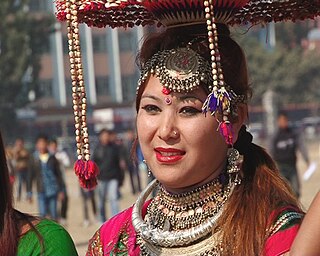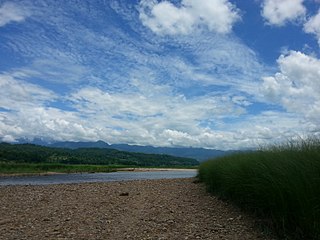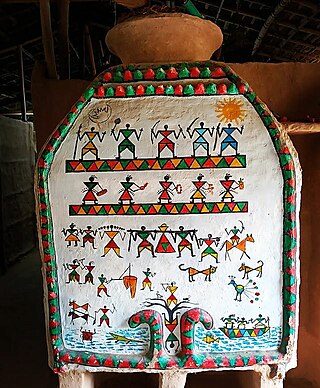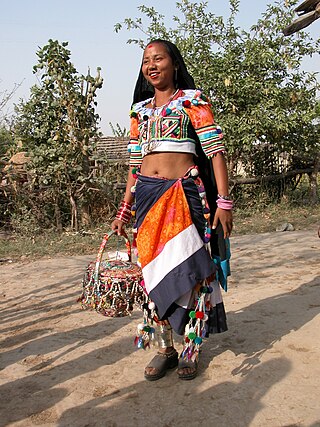
The Tharu people are an ethnic group indigenous to the Terai in southern Nepal and northern India. They speak Tharu languages. They are recognized as an official nationality by the Government of Nepal. In the Indian Terai, they live foremost in Uttarakhand, Uttar Pradesh and Bihar. The Government of India recognizes the Tharu people as a scheduled Indian tribe.

The culture of Nepal encompasses the various cultures belonging to the 125 distinct ethnic groups present in Nepal. The culture of Nepal is expressed through music and dance; art and craft; folklore; languages and literature; philosophy and religion; festivals and celebration; foods and drinks.

Bara District is one of the seventy–seven districts of Nepal, located in the western part of the Madhesh Province. The district is third richest district in Nepal after Kathmandu and Morang with 3.3% share of total GDP of Nepal and highest per capita income in Madhesh province. Kalaiya serves as the district's headquarter. Bakaiya, Jamuniya, Pasaha, Dudhaura and Bangari are the main rivers of Bara. The main languages spoken in the district are Bhojpuri, Tharu, Bajjika, and Nepali.

Kapilvastu District, often Kapilbastu, is one of the districts of Lumbini Province, Nepal. The district, with Kapilbastu municipality as its district headquarters, covers an area of 1,738 square kilometres (671 sq mi) and in 2001 had a population of 481,976, which increased to 571,936 in 2011 and later according 2021 census it further increased to 686,739 Kapilvastu district has 3 number of seats for central whereas 6 seats for state level elections.

Kathmandu District is a district located in Kathmandu Valley, Bagmati Province of Nepal. It is one of the 77 districts of Nepal, covers an area of 413.69 km2 (159.73 sq mi), and is the most densely populated district of Nepal with 1,081,845 inhabitants in 2001, 1,744,240 in 2011 and 2,017,532 in 2021. The administrative headquarters of Kathmandu district is located in thmandu. The city has 21 post offices which handle mail from across the country and beyond, with Kathmandu DPO having 44,600 as its postal code for international mail delivery services like UPS or DHL Couriers etc.

Tanahun District, a part of Gandaki Province, is one of the seventy-seven districts of Nepal. The district lies in central Nepal, with Damauli as its district headquarters. It covers an area of 1,546 km2 (597 sq mi) and has a population (2011) of 323,288. Previously the town of Bandipur was its district headquarter. The postal code of Tanahun is 33900.

Mahendranagar, officially known as Bhimdattanagar, is a municipality in Kanchanpur District of Sudurpashchim Province, Nepal. The city and the municipality were named Mahendranagar in honour of the late King Mahendra of Nepal. After becoming a republic in 2008, the Mahendranagar municipality name was changed to Bhimdatta municipality in honour of the revolutionary farmer leader Bhimdatta Panta. It is surrounded by Bedkot Municipality in the east, Dadeldhura District in the north, Shuklaphanta National Park in the south and Uttarakhand, India in the west.

Maghe Sankranti is a Nepali festival observed on the first of Magh in the Vikram Sambat (B.S) or Yele calendar bringing an end to the winter solstice containing month of Poush. Tharu people celebrate this particular day as new year. It is also regarded as the major government declared annual festival of the Magar community. Maghe Sankranti is similar to solstice festivals in other religious traditions.

Dipayal Silgadhi is a municipality and the district headquarters of Doti District in Sudurpashchim Province of Nepal. Previously, it also served as the headquarters of the Far-Western Development Region. It lies in the Lesser Himalayas on the bank of Seti River. At the time of the 2011 Nepal census it had a population of 32,941 people living in 7,447 individual households.

The Tharu or Tharuhat languages are any of the Indo-Aryan languages spoken by the Tharu people of the Terai region in Nepal, and neighboring regions of Uttarakhand, Uttar Pradesh and Bihar in India.

Jitiya is a three-day-long Ancient Hindu festival which is celebrated from the seventh to ninth lunar day of Krishna-Paksha in Ashvin month. It is celebrated mainly in Nepal and the Indian states of Uttar Pradesh, Bihar and Jharkhand. Mothers fast for well-being of their sons. It is celebrated for eight days in Jharkhand from first moon day to eight moon day in the first half of Ashvin month.
Jur Sital or Maithil New Year is the celebration of the first day of the Maithil new year also called Aakhar Bochhor. Maithils eat Bori with Bhaat and Sondesh on the day. This day which usually falls on 14th or 15th April on Gregorian calendar is celebrated by the Maithils and Tharu people of India and Nepal. This is also called Nirayana Mesh Sankranti and Tirhuta new year. The festive occasion is in keeping with the Tirhuta Panchang calendar used in the Mithila region.
Ashtimki is a Tharu cultural festival celebrated in the Western region of Nepal, on the day of Krishna Janmashtami. During the festival, the people of Tharu community draw a special artwork known as Ashtimki Chitra. The artwork is made on the wall of the living room of the house of the village elder. The art in painting is believed to be related to the creation of the universe.

Ashtimki Chitra is a type of painting drawn on the day of Ashtimki festival celebrated by the Tharu community in the western region of Nepal.

Saama Chakeba is a Hindu festival, originating from the Mithila region of the Indian subcontinent. It is a festival of unity. It is celebrated in November and commences when birds begin their migration from the Himalayas down towards the plains of India. According to the Hindustan Times, the festival, which includes folk theater and song, celebrates the love between brothers and sisters and is based on a legend recounted in the Puranas. It is celebrated by Maithils & Tharu people of India and Nepal.

Sudurpashchim Province is one of the seven provinces established by the new constitution of Nepal which was adopted on 20 September 2015. It borders the Tibet Autonomous Region of China to the north, Karnali Province and Lumbini Province to the east, and India's states of Uttarakhand and Uttar Pradesh to the west and south, respectively. The province covers an area of 19,999.28 km2, or about 13.55% of the country's total area.
Lathi Nach or Jharra Nach also known as Tharu stick dance is a cultural dance of the Tharu people. This dance is mainly performed during the Dashain festival. It is danced striking the small sticks with each other and on its rhythm. It is similar to Dandiya Raas, performed in the Indian state of Gujarat, but varies in movement and style. In this ritual dance all dancers should either be men or women only, as they must wake up holy sprite goddess Durga.

Kochila Tharu, also called Morangiya, Saptari or Saptariya Tharu, Madhya-Purbiya Tharu, and Mid-Eastern Tharu, is a diverse group of language varieties in the Tharu group of the Indo-Aryan languages. The several names of the varieties refer to the regions where they dominate. It is one of the largest subgroupings of Tharu. It is spoken mainly in Nepal with approximately 250,000 speakers as of 2003. In addition to language, cultural markers around attire and customs connect individuals into the ethnic identity Kochila.

Dance is a performing art form consisting of purposefully selected sequences of human movement. Dance (Nepali: नृत्य/ नाच) in Nepal comprises numerous styles of dances, including folk, ethnic, classical to modern dances. Lakhey is the dance of a demon in the carnival of God. Durbar Square, a historic plaza in Kathmandu, Nepal, facing ancient palaces and adorned by Hindu temples, is always full of eager crowds on the last day of Indra Jatra, the festival celebrating Indra, the Hindu king of heaven. In this divine stage, Lakhe the demon dances among gods and deities relentlessly and carelessly.

Rana Tharu is an ethnic group generally classified as part of the Tharu people of Nepal and India. They are living in Kailali and Kanchanpur Districts of the far western Nepali Terai and also in India, in Udham Singh Nagar district, Uttarakhand and Kheri district of Uttar Pradesh. As of 2001, Rana Tharu people were the largest of five scheduled tribes in Uttarakhand, with a population of 256,129 accounting for 33.4% of all scheduled tribes.
















